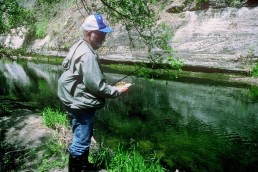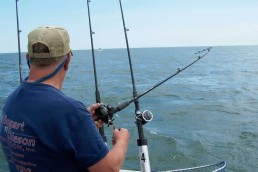Stream Walking Can Yield Great Rewards
SHARE THIS POST
Early spring is a time to explore creeks and streams in search of some offbeat fishing holes. It comes early in the South, which provides southern anglers an early opportunity to catch hungry fish. With a little planning and careful walking, anglers can find water that is his and his alone.
Stream walking can be as simple as moving up and down the shoreline to find a seemingly better spot or wading to another location for better placement of bait.
Stream walking is fishing in its most elementary form—it is cheap, simple and safe. Prices for the tackle vary, but seldom go over $100 and the equipment is useable for years with little upkeep.
Stream walkers do require some specialized equipment. Foremost among these are waders. The best ones are chest waders. In hot weather some people prefer hip boots, but getting into deeper water requires higher-sitting protection. It is probably still a good rule of thumb though to stay in water below that’s up to the tops of hip boots.
Another good protective gear is wearing a belt around the waist of chest waders to slow the flow of water into the waders in case of a misstep. Wearing a belt outside the waders and wearing suspenders that come with the waders keep water out.
Also, it is important to wear good sun block for skin protection from cancer-causing rays of the sun. A wide-brimmed hat also helps. Polarized sunglasses help protect the eyes from the glare of the sun off the water and aid in seeing fish.
Often, one carries a rod and reel in one hand and a wading stick in the other to test water depths. Any tackle can be placed in the pockets of a fly fishing vest or in a daypack or backpack. Some items for the bag can include a pocket knife, hooks and sinkers, lures, a camera, hook removers and food and drinks.
Are you enjoying this post?
You can be among the first to get the latest info on where to go, what to use and how to use it!
When taking to the water know where you set your feet; walk slowly. Try to avoid committing yourself to a full step until you have felt the area ahead of you with a probing toe or walking stick. Walking slowly also keeps one from creating an unnecessary wake or disturbing the fish by making noise.
Stream walking is “stalking” fish. Try to find likely places for easily spotting fish, and then cast or present bait to the fish in an attempt to entice them.
Travel upstream to avoid disturbing resting fish. Any stirred up silt when walking in water can move downstream. Traveling this direction can also help control the amount of sound disbursed from the angler walking over rocks and debris.
Never wade in recent rain-swollen water or in any open water when the possibility of lightning strikes with a storm in the area hasn’t moved out. When safe, after a heavy rain or when backwaters are flooded, the angler might be able to get back into water rarely fished; there is no telling what one might find in an area previously thought fished-out. Flooding restocks some of these areas every time they get flooded. Still, know the water you’re stepping because the bottom constantly changes. An area that was shallow may now be deep. And an area once clear may now contain logs and trees.
Fishing takes time, patience and skill. Wading is a challenging method that sometimes yields great rewards. In any event, it can be quality fishing time.
Don Gasaway is a veteran outdoor writer from Marion, Ill. He may be contacted at: dongasaway.wordpress.com or facebook.com/DonsJournal.
MWO
SHARE THIS POST
You may also like...
0 CommentsGreat Shallow-water Bass Action Right Now
Did you enjoy this post?
You can be among the first to get the latest info on where to go, what to use and how to use it!
Don Gasaway
Don Gasaway is a veteran freelance outdoor writer from Marion, Ill. He may also be found at: https://www.facebook.com/DonGasawayWriter and facebook.com/Wandering Angler. Comments are welcome


